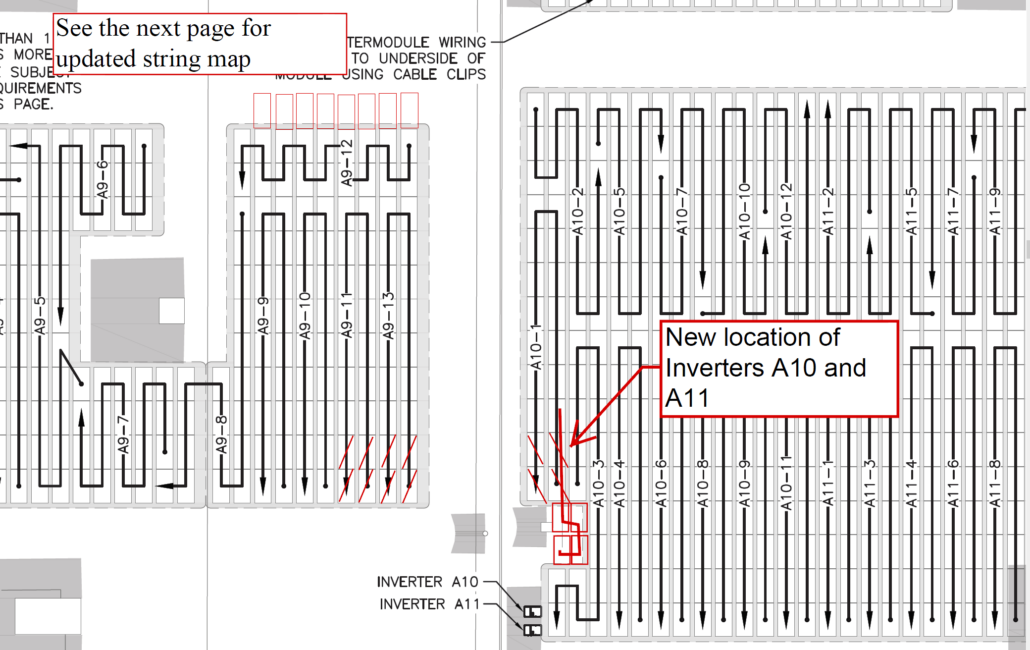As an Owner’s Engineer, Pure Power frequently assists clients in making critical strategic decisions regarding the repair, repowering, or optimization of their operational solar assets. In this capacity, our team of experts and engineers often relies on the record drawings provided by the installing contractor once the project is completed and accepted. However, when these record drawings fail to align with the actual as-built conditions, project owners and operators face the risk of incurring unnecessary and avoidable costs.
What Are As-Built Drawings?
As-built drawings are updated versions of the original engineering construction drawings that accurately reflect the actual conditions on-site. Throughout the construction process, the installing contractor is responsible for documenting any deviations between the formal construction drawings and the actual as-built conditions. These informal change-tracking documents are commonly referred to as red-line drawings. Redlines capture significant modifications made during the construction phase. Once the project is complete, the contractor must generate a final set of drawings incorporating these redline updates. The as-built drawings serve as a comprehensive record of these changes.

Who Is Responsible for As-Built Drawings?
After the project becomes operational, the ultimate responsibility for ensuring the accuracy of the as-built drawings falls on the project owner. This is an ongoing process involving multiple stakeholders:
- **Installing Contractor**: During construction, the installing contractor manages and updates the as-built drawings. This is both a best practice and a necessary precaution since the contractor is accountable for acceptance and approval of changes from developers, owners, or financiers. Most contracts explicitly require the contractor to deliver accurate as-built drawings upon project completion.
- **Independent Engineer**: While accurate as-builts are crucial for efficient plant operations, some installing contractors may lack the resources or processes to fully document all changes. In such cases, some owners hire an independent engineer to verify the actual conditions before project acceptance. A third-party inspection helps prevent errors or inaccuracies in the contractor's drawings from complicating asset management post-commercial operation date (COD).
- **Asset Manager**: Assuming the as-builts are correct at COD, owners must ensure they stay accurate as changes occur during operations and maintenance. Many owners outsource these responsibilities to an asset manager who has a vested interest in keeping project drawings up-to-date to maximize operational efficiency.

Best Practices for Project Owners and Operators
Inaccurate as-built drawings can lead to costly planning errors and inefficiencies during project operations. Without accurate drawings, stakeholders cannot make informed decisions about design improvements or component replacements. Here are some practical tips for ensuring your project as-builts are precise:
- **Get It Right During Construction**: Every construction contract for new solar projects should include a requirement for as-built drawings upon completion. To ensure accuracy, contracts should mandate engineering oversight before acceptance. The owner’s engineer should confirm, as part of the closeout punch list, that the installing contractor provides these contractually required as-builts.
- **Update Legacy Systems**: Never depend solely on outdated drawing sets. The likelihood of undocumented changes increases with each passing year after COD. Before planning capital improvements in legacy systems, owners should commission an inspection to verify that the legacy drawings are current and accurate. The cost of updating the drawings is minimal compared to the potential expenses from errors caused by outdated or inaccurate as-builts.
- **Maintain Digital Records**: Starting with digital redlines reduces the risk of miscommunication or loss of information. We recommend maintaining redlines and as-builts in digital format from the beginning. This approach ensures that all changes are consistently captured in the latest drawings.
- **Implement Revision Control**: After issuing construction documents, all changes to the drawings become part of an ongoing formal revision process. This process begins with the construction redlines and continues indefinitely while the solar project remains operational. Having rigorous and well-defined revision control practices in place for managing files, documents, and versions will enhance operational efficiencies and reduce long-term project costs.
By adhering to these best practices, project owners and operators can significantly improve the reliability and efficiency of their solar assets, minimizing risks and maximizing returns.
Drive Shaft
Here you can find the related products in Drive Shaft, we are professional manufacturer of Drive Shaft Manufacturer, Car Drive Shaft, Front Drive Shaft,Axle Drive Shaft, Rear Drive Shaft.
We focused on international export product development, production and
sales. We have improved quality control processes of Drive Shaft to
ensure each export qualified product.
If you want to know more about
the products in Drive Shaft, please click the product details to view
parameters, models, pictures, prices and other information about Drive Shaft Manufacturer, Car Drive Shaft, Front Drive Shaft,Axle Drive Shaft, Rear Drive Shaft.
Whatever
you are a group or individual, we will do our best to provide you with
accurate and comprehensive message about Drive Shaft!
Drive Shaft Repair,Drive Shaft Shop,,Drive Shaft Axle,Car Drive Shaft,Front Drive Shaft,Axle Drive Shaft,Rear Drive Shaft
Guangzhou Taixin Auto parts Trading Co., Ltd. , https://www.hyundai-autopart.com